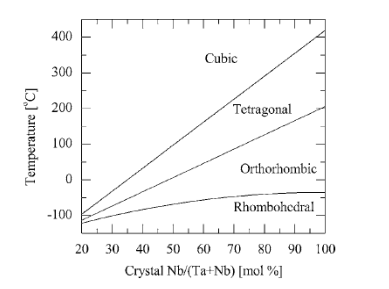Single crystal KTaNbO3 is available from PAM-XIAMEN. Potassium tantalum niobate (KTa1-xNbxO3; KTN for short) crystal is a kind of multifunctional crystal material with high electro-optical coefficient, good piezoelectric and pyroelectric effects. It has significant electro-optical and photorefractive effects. The KTaNbO3 crystal is generally grown by the melt method and has good thermal stability, chemical stability and mechanical stability. Based on the above advantages, KTN crystals have a wide range of applications in the fields of nonlinear optics, optical storage, optical communications and optoelectronics. At the same time, single crystal of KTN is widely used as an excellent film material and substrate material. KTaNbO3 is transparent isotropic crystal with very large electro-optic coefficients of about >600 pm/V, which is 20 times larger than that of conventional LiNbO3. You can buy the following specifications:

1. Specifications of KTa1−xNbxO3 Single Crystals
| KTN (KTa1-0.33Nb0.33O3) Crystal Substrate | |
| Crystal Structure | Cubic Crystal |
| Lattice Constant | a=3.989-4.1 A |
| Density | 7.015g/cm3 |
| Curie temperature | 20-30℃ |
| Melting Point | 1350℃ |
| Thermal Conductivity | 0.17 w/m.k at 300K |
| Electro-optic Coefficient | r33:>600pm/V |
| Refractive Index | 2.234 |
| Coercive Magnetic Field | Ec=250V/mm |
| Transmission Range | 400nm-4000nm |
| Growth Method | Top seed crystal melting method |
| Crystal Orientation | (100) |
| Sizes | 10x10x0.5mm, 5x5x0.5mm |
| Surface Finish | SSP, DSP |
| Surface Roughness | <10A |
| Note: Size and orientation can be customized | |
KTN (100) 5x5x0.5mm, 2sp
Orientation: (100) +/-0.5 °
Size: 5x 5 mm x 0.5mm
Polish: two sides optical grade polished
Surface finish (RMS or Ra) : < 5A
Packed: each in membrane box
KTN (100) 10×10.6×0.5 2sp,
Orientation: (100) +/-0.5 °
Size: 10mm x 10.6mm x 0.5mm
Polish: two sides optical grade polished
Surface finish (RMS or Ra) : < 5A
Packed: each in membrane box
2. Crystal Structure and Optical Properties of Single Crystal KTaNbO3
Potassium tantalum niobate, chemical formula KTa-_Nb.O3, is a mixture of potassium niobate KNbO3 (denoted as KN) and potassium tantalate KTaO3 (denoted as KT), and KTN crystal presents a solid solution mixture of the two crystal. Both KT and KN belong to the ABO3 type perovskite structure. The ABO3-type perovskite structure is formed by octahedral BO6 connected at a common vertex angle, and the gap between them is filled by the metal ion A. In KN and KT, the octahedral structures of NbO6 and TaO6 are connected to form the basic structure in a common vertex angle, and the monovalent K ions fill the gaps. Their structures are very similar and can be dissolved in any ratio to form a solid solution. The perovskite structure of KTN crystal is show as in the Fig.

There are four crystal phases in KTaNbO3 single crystal. The phase change structure is derived from KN. From high temperature to low temperature, the phase change of KN is from cubic, tetragonal, orthogonal to rhombohedral. The temperature at which the phase change occurs is 435, 220, and -40°C, respectively. The crystal phase of KT crystal is cubic crystal phase, which will not change with temperature. The phase transition temperature of KTaNbO3 is related to the Ta/Nb doping concentration, and the relationship between the phase transition temperature and the Nb doping concentration is shown in the figure.

It can be seen from the image that the doping concentration coefficient x of Nb is about 0.4. The phase transition temperature of the crystal from the four directions to the cubic phase is around room temperature. This temperature is called the Curie temperature. This transition is accompanied by changes in dielectric and electro-optical properties. The cubic phase KTaNbO3 has inversion symmetry, the crystal appears as a paraelectric phase, and the low-order electro-optical effect appears as the Kerr effect, that is, the secondary electro-optical effect. The tetragonal phase KTN crystal appears as a ferroelectric phase, and the low-order electro-optic effect appears as a primary electro-optic effect.
3. KTaNbO3 Crystal Growth
By controlling suitable growth process parameters, the pulling method is successfully used to grow high-quality and large-size potassium tantalate niobate crystals from the KT-KN melt system. Through reasonable temperature field design and growth parameter control, large crucibles are used to grow small crystals. The process method successfully improves the crystal quality problem. The composition of KTa1-xNbxO3 crystals is determined by two factors, the ratio of raw materials and the growth temperature, among which the ratio of raw materials is the main determining factor. Establishing a suitable temperature field is the prerequisite for the growth of high-quality single crystals; controlling suitable growth process parameters is the key to crystal controlling raw material components and avoiding excessive growth are to improve crystals growth; selecting high-quality seed crystals, using appropriate raw material synthesis processes, quality.
Kindly note: Due to the rapid changes in the semiconductor wafer market and our production lines, our supply capacity will change with it, but the changes will not be shown on our website. So we reserve the right to explain all the wafer information on our website.
For more information, please contact us email at victorchan@powerwaywafer.com and powerwaymaterial@gmail.com.

